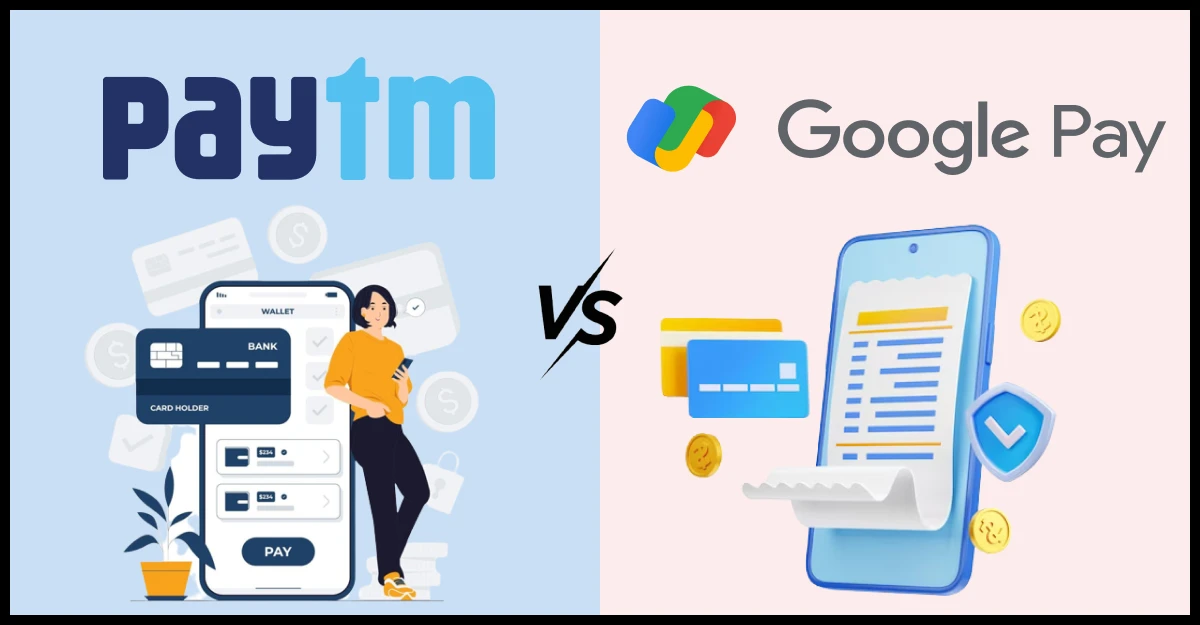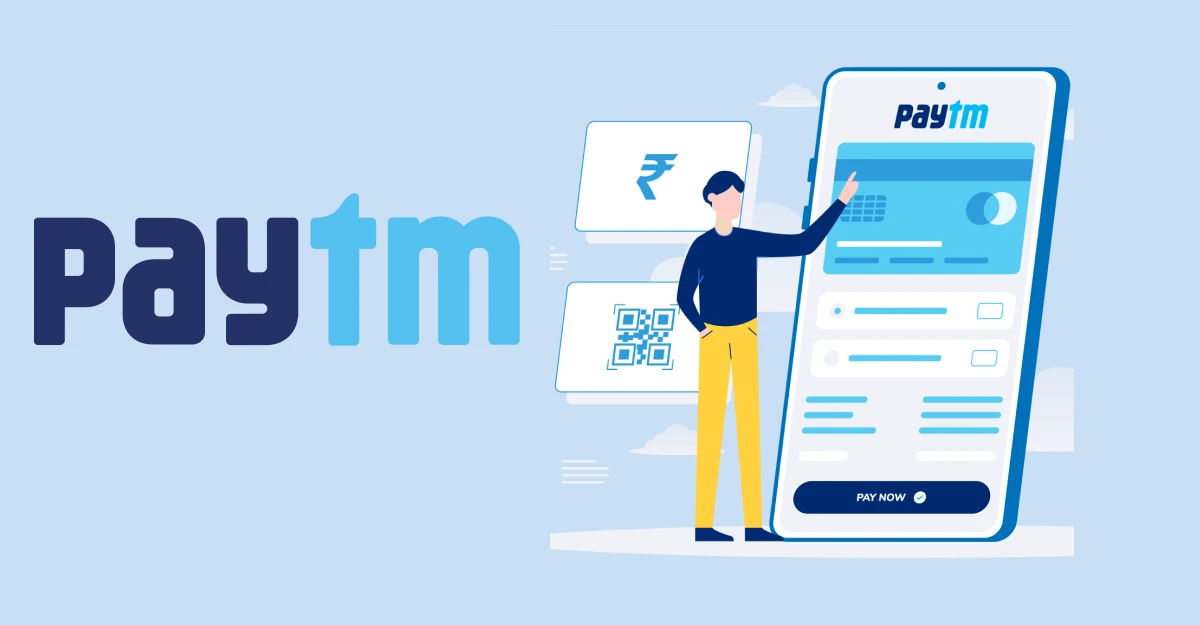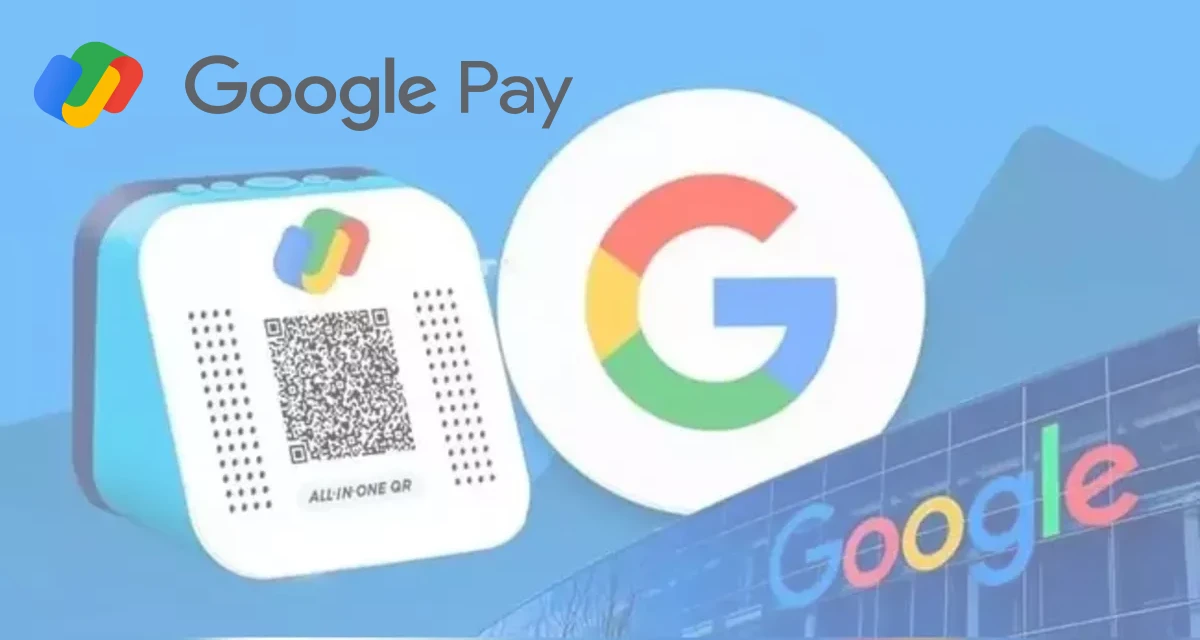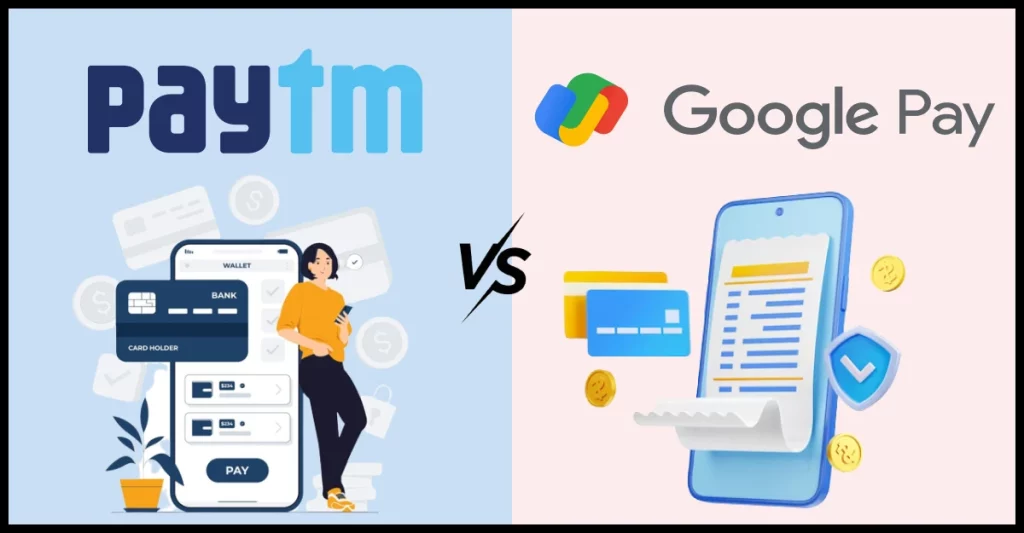Are you curious about the battle between payment giants? In the digital realm, two players are the major contenders i.e. Paytm vs Google Pay, each vying for supremacy.

From seamless transactions to enticing offers, both platforms have carved their niches. But the burning question remains- which truly dominates the business landscape? Join me as we delve into the Paytm vs Google Pay showdown, exploring their features, user experiences, and market presence.
In the comparative analysis of Paytm vs Google Pay, we will unravel the intricacies of these digital payment powerhouses. Also, you will get to know who holds the crown in this dynamic arena.
Stay tuned!
Paytm vs Google Pay: A Brief Overview
First of all, let’s have a look at the profile of both the companies-
| Particulars | Paytm | GooglePay |
| Year Founded | 2010 | 2015 |
| Parent Companies | One97 Communications | |
| Country of Origin | India | United States |
| Available in India | Yes | Yes |
| Operating Industry | Financial technology, E-commerce, Digital Payment | Digital Payment |
| Founder | Vijay Shekhar Sharma (CEO) | Sujith Narayanan, Sumit Gwalani |
| Headquarters | Noida (Uttar Pradesh, India) | New Delhi (Indian Headquarter) |
| Areas Served | India, Japan | 42 Countries (Areas where Google Pay is available.) For iPhone and iPad, it is available only in the US and India |
| Products | Paytm Insider, Paytm Payments Bank, Paytm Money, PayPay, Paytm Insurance, Paytm First Games | GPay |
| Services | Payment Systems, Mobile Payments | Digital Payment, Group Payments, Bill Payments, Split Bills |
| Competitors | PhonePe, GooglePay, PayPal | PayPal, Paytm, PhonePe, Samsung Pay, Cash App, Payoneer |
In the upcoming sections, we will learn about both the companies in detail.
Paytm: Indian Digital Payment App

In 2010, Vijay Shekhar Sharma founded Paytm under One97 Communications, marking the inception of an Indian digital payment and financial services company. Initially, Paytm focused on prepaid mobile and DTH recharge and expanded to include debit cards, postpaid mobile, and landline bill payments in 2013.
Renowned as India’s largest e-commerce company for digital transactions, Paytm is a trusted platform utilized by millions for shopping, cash transfers, ticket bookings, and everyday bill payments.
Notably, Paytm achieved a significant milestone in 2017 by becoming the first payment app in India to surpass 100 million downloads. In March 2021, Paytm proudly reported 1.2 billion monthly transactions and boasted over 150 million monthly active users. Also, it reached nearly 88% of Indian villages, primarily in Tier 2 and Tier 3 cities.
Paytm’s diverse services encompass mobile recharges, utility bill payments, travel bookings, movies, and event reservations.
Additionally, it facilitates in-store payments at various establishments, from grocery stores and restaurants to pharmacies and educational institutions, using the Paytm QR code.
In India, you won’t find a single shop or vendor without a Paytm scanner! And that’s the evidence signifying the grand success of Paytm in India.
Note: Apart from Paytm, Indians massively use PhonePe too! Now who is the winner in Paytm vs PhonePe? We have already covered this concept thoroughly here- “Paytm vs PhonePe: Who is the winner?” Go through this article and you will get the answer.
GooglePay: Payment Service of Google

Google Pay, born as Google Wallet in 2011, underwent a transformative journey, briefly adopting the moniker Android Pay in 2015 before finally settling on its present name in 2018.
This digital wallet and online payment system by Google operates in 42 countries, catering to Android users with version Lollipop 5.0 and above. While its compatibility extends to Android phones, watches, and tablets, Google Pay also supports iOS devices, albeit with some limitations. It means that Google Pay is available on iOS devices only in the US and India.
As of 2021, Google Pay boasts a user base exceeding 150 million, orchestrating a staggering 2.5 billion transactions with a cumulative transaction value surpassing $110 billion. The app collaborates with various banks and financial institutions, providing an array of services such as bank transfers, money transactions, and online shopping. Users can also reap rewards through the Google Pay Rewards program.
In a notable December 2021 development, Google Pay forged a partnership with Mastercard, allowing users to transact seamlessly using Mastercards via token, eliminating the need for divulging debit card details. Interestingly, Google Pay finds a higher frequency of in-store payments in India and Switzerland compared to the United States and the UK.
Similarly, its usage prevails on websites in Canada, New Zealand, and Ireland over U.S. websites and European platforms.
Paytm vs Google Pay: Comparing the Features
Now, let’s compare the features of both digital payment titans-
| Features | Paytm | GooglePay |
| Supported Platforms | Android, iOS, Web | Android & Web (iOS only available in India and the US) |
| Payment Methods | UPI, Wallet, Credit/Debit Cards, Net Banking | UPI, Wallet, Credit/Debit Cards, Net Banking |
| Transaction Limit | UPI: INR 1 Lakh/day, Wallet: INR 10,000/month | UPI: INR 1 Lakh/day, Wallet: INR 20,000/month |
| Cashback Offers | Available | Available |
| Reward Programs | Paytm First | Google Pay Rewards |
| International Transactions | Not available | Available |
| Customer Support | Available by email, phone, or chat. | Available by email, phone, or chat. |
So, here you’ve got two major players in front of you—Paytm and Google Pay. Let’s break down the nitty-gritty details from the table.
First off, both Paytm and Google Pay have your back on various devices, but Paytm goes all-in with Android, iOS, and the web, while Google Pay keeps it cool with Android and the web, throwing iOS into the mix just in India and the US.
Now, when it comes to the way you can splash the cash, both are on the same page—UPI, Wallet, Credit/Debit Cards, and Net Banking. But here’s where the plot thickens: Paytm has its limits with a daily cap of INR 1 Lakh for UPI and a monthly wallet limit of INR 10,000. Google Pay, on the other hand, ups the game, allowing INR 1 Lakh/day for UPI and a wallet cap of INR 20,000/month. Your spending habits might sway your vote here!
Cashback offers and rewards?
Oh, they’re on the menu for both!
Paytm brings you the “Paytm First” vibes, and Google Pay has its own charm with “Google Pay Rewards.” It’s like getting treats for using their services—win-win!
When the foreign transaction kicks in, Google Pay takes the lead, letting you make international transactions. Paytm, unfortunately, stays grounded and doesn’t spread its wings for cross-border transactions.
And when you’re in a digital pickle, worry not! Both Paytm and Google Pay have your back with customer support through email, phone, or chat. They’re there to untangle any knots you might find yourself in.
So, whether you’re team Paytm or team Google Pay, this breakdown should help you make a choice that fits your style and wallet!
Paytm vs Google Pay: Business Comparison
Here comes the most anticipated part of the article. You must be wondering who is winning in terms of business. Well, go through the following table and you will find out.
| Business Aspects | Paytm | GooglePay (India) |
| Market Cap (2024) | Rs.48,450 crore | Rs.12 crore |
| Market Share (2023) | 15% | 34% |
| User Base | Over 350 million | 150 million |
| Monthly Transactions | 134.22 crore | 327.46 crore |
| Transaction Value | Rs.1.64 lakh crore | Rs.4.97 lakh crore |
| Services Offered | Mobile recharges, bill payments, travel bookings, in-store payments via QR code | Bank transfers, money transactions, online shopping, rewards program |
| Partnerships | Collaborates with banks and financial institutions | Partnered with Mastercard for tokenized transactions (December 2021) |
| Geographical Usage Trends | Popular for in-store payments in India and Switzerland | Used more frequently on websites in Canada, New Zealand, and Ireland compared to U.S. websites or European platforms |
| Contributions/Investments | Contribution to PM Cares fund during the COVID-19 pandemic, investment from Ratan Tata | Supported by Google (Parent Company) |
Let’s take a stroll through the business battleground of Paytm and Google Pay, where numbers and market dynamics paint a vivid picture of their prowess.
In the currency of competition, Paytm boasts a substantial market cap of Rs.48,450 crore in 2024, while Google Pay, a formidable contender, weighs in at Rs.12 crore. The market share from 2023 reveals a narrative of dominance, with Paytm securing 15% and Google Pay clinching a notable 34%.
User engagement, a pivotal metric, unfolds an interesting story. Paytm stands tall with an expansive user base exceeding 350 million, showcasing its widespread popularity. In contrast, Google Pay in India claims a user base of 150 million, a significant figure but trailing behind Paytm in sheer numbers.
As we delve into the transaction landscape, Paytm registers 134.22 crore monthly transactions, a testament to its consistent usage. Google Pay, on the other hand, surges ahead with a staggering 327.46 crore monthly transactions, underscoring its dominance in transactional volume.
The financial tapestry is woven with transaction values, and here, Google Pay unfurls a colossal Rs.4.97 lakh crore, overshadowing Paytm’s transaction value of Rs.1.64 lakh crore. The disparity underscores Google Pay’s commanding presence in the financial landscape.
Diversification in services reflects distinct strategies. Paytm casts a wide net with mobile recharges, bill payments, travel bookings, and in-store payments via QR code. Meanwhile, Google Pay positions itself as a versatile player, offering bank transfers, money transactions, online shopping, and a robust rewards program.
Geographical trends add a global perspective, with Paytm reigning supreme for in-store payments in India and Switzerland. In contrast, Google Pay finds its stride on international websites, especially in Canada, New Zealand, and Ireland, surpassing its traction on U.S. websites and European platforms.
Behind the scenes, contributions and investments echo commitment. Paytm’s involvement in the PM Cares fund during the COVID-19 pandemic and investments from influential figures like Ratan Tata highlight its societal and financial engagement. On the Google Pay front, being under the wing of Google as its parent company adds a layer of substantial support and backing.
In the end, this business duel is measured in terms of user numbers, transaction volumes, and strategic maneuvers, each thread contributing to the unique narrative of Paytm and Google Pay in the dynamic landscape of digital payments.
Paytm vs Google Pay: Comparing the Financial Numbers
In the following table, you can see the financial performance of Paytm and Google Pay for the fiscal year 2023-
| Financial Metrics | Paytm | GooglePay |
| Revenue Earned | ₹7,990 crore | ₹3.76 crore |
| Expenses | ₹10,130 crore | ₹17,500 crore |
| Operating Income | -₹1,730 crore | Not available |
| Net Income | -₹−1,568 crore | Not available |
| Profit | ₹42.76 crore | RS.53 crore (FY21) |
Let’s dive into the financial seas of Paytm and Google Pay, where the numbers tell a tale of revenue, expenses, and profits. In the fiscal year 2023, Paytm earned a robust ₹7,990 crore in revenue, reflecting its significant financial clout. On the flip side, Google Pay posted a comparatively modest ₹3.76 crore in revenue, signaling a different trajectory.
Expenses, the financial adversaries that companies grapple with, unveil intriguing dynamics. Paytm navigated through ₹10,130 crore in expenses, showcasing the substantial operational costs it faced during the fiscal year. Meanwhile, Google Pay encountered a more formidable financial battleground, with expenses soaring to ₹17,500 crore, indicating the challenges it confronted.
Operating income, a pivotal metric in financial evaluations, paints a nuanced picture. Paytm found itself in the red with an operating income of -₹1,730 crore, signifying a deficit in its operational balance. In contrast, specific data for Google Pay’s operating income is not available, leaving room for speculation regarding its fiscal resilience.
Net income, the bottom line reflecting profit or loss after all expenses, unveils a financial snapshot. Paytm faced a net loss of -₹1,568 crore, grappling with the intricacies of financial balance. Google Pay’s net income remains undisclosed, adding an element of mystery to its fiscal narrative.
The grand finale in this financial saga is the profit earned. Paytm managed to carve out a profit of ₹42.76 crore, showcasing its ability to navigate the financial landscape successfully. In comparison, Google Pay reported a profit of ₹53 crore in the fiscal year 2021, positioning itself as a financially viable player in the digital payment arena.
In short, this financial face-off between Paytm and Google Pay illuminates the intricacies of revenue generation, operational challenges, and the ultimate pursuit of profit. The numbers, in their varied hues, tell a compelling story of financial resilience and strategic maneuvering in the ever-evolving world of digital payments.
Summing Up Paytm vs Google Pay: Who is the winner?

In the dynamic field of digital payments, Paytm and Google Pay each showcase distinct strengths. Paytm’s extensive user base and diverse services, coupled with its financial resilience, define its narrative. Conversely, Google Pay stands out with transactional dominance, international reach, and robust support from Google.
Both platforms contribute significantly to the evolving landscape of digital payments. The determination of which is performing better in business depends on individual priorities. Whether one values the widespread user base and varied services of Paytm or the transactional prowess and global presence of Google Pay, users have a rich array of options.
The conclusion remains open-ended, inviting users to explore and align their preferences with the unique offerings of Paytm and Google Pay in the thriving digital economy.
By the way, which one do you use the most and why? Don’t forget to comment down below!

